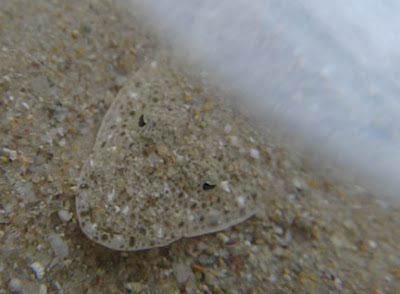I'm back on Cyrene with another enthusiastic group of Shell volunteers!
Thanks to their sporting spirit, despite the wet start, we had fun! And saw lots of stuff, especially animals with prickles!
Hurray, the tide is as low as predicted! I was worried because during the last low spring tide cycle, the tide was higher than predicted, which makes it difficult to work on a submerged reef. We make quick and safe landing as usual, thanks to Alex and his crew of Summit Marine.
As we walk away from the landing point, a huge cruise ship passes by this major shipping lane next to Cyrene Reef. Although Cyrene lies in the middle of the industrial triangle it has amazing marine life! Alas, it starts to rain heavily just as we are assembled on the sand bar!
But we are quickly distracted by the many amazing creatures found right at our feet. There are lots of Common sea stars (Archaster typicus)!
We take a closer look at some tiny parasitic Ulimid snails (Family Eulimidae) that were found on one of the Common sea stars. These snails stick their proboscis through the body wall of the sea star and suck on the host body fluids. Eew.
There were also lots of Cake sand dollar (Arachnoides placenta), which are flat disks with tiny prickles. These sand dollars are eaten by Grey bonnet snails (Phalium glaucum). Usually, these snails are buried in the sand and only come out at night. But we saw lots and lots of them during this trip. Perhaps due to the rainy weather?
Here's one Bonnet snail eating a sand dollar while buried under the sand! We had gently scraped away the sand to look at it, then carefully buried it again.
Elsewhere in the sand bar, we spot these buried snails by the long worm-like white siphon that sticks up above the surface!
There were lots and lots of White sea urchins (Salmacis sp). Not only in the seagrass meadows, but also on the sandy areas. These prickly little balls were camouflaged by their habit of 'carrying' bits of debris. This sea urchin is more common on our northern shores like Chek Jawa and seldom seen on our southern shores. Indeed, I consider Cyrene the Chek Jawa of the South.
These prickly animals use their spines to move, and they tickle!
Many of them had a banded 'worm' around the mouth, which is found on the underside of the sea urchin. I still haven't figured out what the worm is.
Azlin found another prickly little thing which he thought at first was a Sea almond seed. It's tiny and very prickly. It's a heart urchin (Lovenia sp.)!
After taking a look at it, we put it on the sand and watched as it burrowed away rapidly. We rarely see these animals above ground!
Ah, another prickly creature. This one is the Thorny sea urchin (Prionocidaris sp.) also called the Pencil sea urchin because its spines are thick and spiny.
We also saw a small sandy fish hiding in the sand. I think it's a Bartail flathead (Platycephalus indicus), which I've not seen on Cyrene yet.
Oh! A tiny octopus!
One of the sharp eyed visitors spots a blue Flower crab (Portunus pelagicus). It took a while before we noticed the smaller brown crab in front of it. It's probably a pair of crabs about to mate! We also saw many small flower crabs among the seagrasses.
More sharp-eyed spotting, this time a very long red ribbon worm (Phylum Nemertea)! These worms are fierce predators and I seldom see them during daylight.
Carpet anemones (Stichodactyla haddoni) usually have a pair of anemone shrimps (Periclimenes brevicarpalis) living in it. The female is larger with more white spots.
We also saw pretty Cerianthids (Order Ceriantharia), also called Peacock anemones because of their colourful variety. But these are not true sea anemones.
Besides seagrass meadows and sandy shores, Cyrene also has short stretches of rocky shores!
It took me a while, but we finally found the patch where many of the Knobbly sea stars (Protoreaster nodosus) gather together. Alas, by then the tide was starting to come in and the sun was setting.
Other creatures we saw include: Fan shell clams (Family Pinnidae), Black lipped conch (Strombus urceus) a snail that hops, Stone crab (Myomenippe hardwickii), Chocolate sponges (Spheciospongia cf. vagabunda), sand collars laid by moon snails, different kinds of hermit crabs. Also of course, lots of seagrasses and various kinds of seaweeds.
Fortunately, the rain cleared earlier on so we had a mostly dry trip! But tides move on and so we have to leave eventually. Cyrene is vast and is impossible to explore completely in one trip. And we keep seeing new things everytime we visit!
Thanks to Azlin for organising the trip, the wonderful team of Shell volunteers for finding so many interesting animals and putting up with my very lame jokes, and of course Alex for taking us there and back safely.
I look forward to another trip to Cyrene with the Shell volunteers later today!
More about Cyrene Reef.























